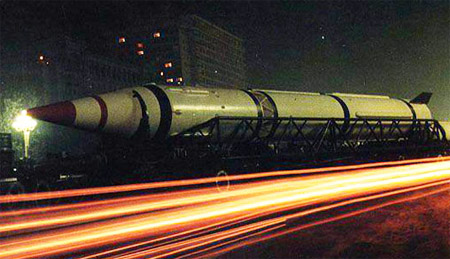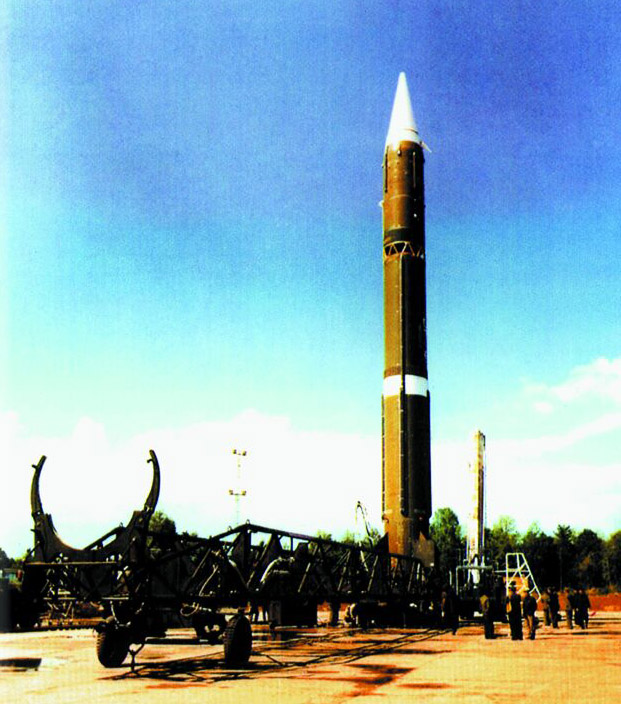| DongFeng 4 (CSS-3) Intermediate-Range Ballistic Missile
中国DF-4(CSS-3)中程弹道导弹 Date:2013-10-26 Source:internet By:globalmil Viewed: |

The DongFeng 4 (NATO reporting name: CSS-3) liquid-propellant, two-stage intermediate-range ballistic missile (IRBM) was developed by the China Academy of Launch Vehicle Technology (CALT, also known as 1st Space Academy) in the 1960s. The missile entered operational service in the early 1980s, with approximately 20 missiles (2008 Pentagon report) currently deployed by the PLA Second Artillery Corps. The DongFeng 4 was also used to develop PRC’s first space launch vehicle Changzheng 1 (Long March 1), which sent the country’s first satellite into the orbit in 1970.
东风(DongFeng)-4(DF-4,北约报告命名:CSS-3)液体-推进,二级中-程弹道导弹(IRBM)在1960年由中国运载火箭技术研究院(CALT),也即是第一空间研究院发展。导弹在1980年早期进入操作服役,目前大约20枚导弹(2008年五角大楼报告)在PLA第二炮兵部署。DF-4也用来发展中国的第一种空间运载火箭长征(Changzheng)-1型(Long March 1),在1970年运送本国第一颗人造卫星进入轨道。
Programme
Following the successful test of atomic weaponry in 1964 and a thermonuclear (hydrogen) device in 1967, the next step of PRC’s strategic weapon programme was to develop delivery systems with different ranges. The two-stage DongFeng 4 began development in 1967 and its development essentially took place in parallel with the single-stage DongFeng 3 (CSS-2). The DongFeng 4 was based on the same liquid propellant rocket engine of the DF-3, but with a second-stage which increased the missile’s range to over 4,000km. During its development, the design team encountered a number of technical difficulties, including the ignition of the second-stage rocket at high-altitude and the warhead’s re-entry heat-proof shield.
计划
在1964年的核武器和1967年热核(氢)装置成功测试之后,中国战略武器计划的下一个步骤去发展不同射程的递送系统。二级DF-4在1967年开始发展,而且它实质上和单级DF-3(CSS-2)平行发展。DF-4以DF-3相同的液体推进火箭发动机为基础,但是由于采用了第二级增加导弹射程达到4,000公里。在它发展时,设计队伍遇到了许多技术上的困难,包括第二级火箭在高空点火和再入隔热罩。
The first flying test of the DongFeng 4 missile took place in November 1969, but the first and second stages of the missile failed to separate due to commanding system failure and the missile was self-destructed. The revised missile was tested again in January 1970 with complete success. Following a redesign in order to increase the range, the missile was retested in May 1976. The missile first entered operational service with the PLA Second Artillery Corps between 1979 and 1980.
DF-4导弹的首次飞行测试在1969年11月进行,但是导弹由于指令系统故障第一级和第二级没有分开并且导弹自毁。改进导弹在1970年1月再一次测试并成功完成。接着重新设计为了要增加射程,导弹在1976年5月再次测试。导弹在1979年和1980年之间进入PLA第二炮兵操作服役。
The DongFeng 4 was the first ballistic missile of the PRC that posed a real threat to the Soviet Union, with its 4,750km range enough to reach Moscow and a number of other key Russian cities. The missile could also threaten U.S. military bases in its Asian allies, though it still could not reach the U.S. mainland. The missile’s primitive inertial guidance was insufficient to hit point targets such as missile sites, but the size of its warhead was enough to destroy large population centres and military complexes. This capability significantly boosted PRC’s ability to counter the nuclear threats of the Soviet Union following the split of the two communist allies in 1960.
DF-4是中国对苏联造成真正威胁的第一种弹道导弹,由于它4,750公里射程足够到达莫斯科和许多的其它主要苏联城市。但是,导弹也可以威胁美国在亚洲的军事基地,虽然它仍然不能到达美国大陆。导弹简单的惯性导航不足以去打击点目标,像是导弹发射场, 但是它的弹头规模足以摧毁大规模人口城市和军事集群。这一个能力重要地提升中国的能力
去对抗苏联的核威胁。

DongFeng 4 in the launch position (Chinese Internet)发射位置的DF-4(中国英特网)
Design
The DongFeng 4 is a two-stage, single-warhead liquid-propellant ballistic missile. The missile has a maximum range of 4,750km and a payload of 2,200kg. It carries a single 1,000~3,000kt thermonuclear warhead, with an accuracy of around 1,500m. The missile body has four clipped delta fins at the base of the first stage. The first stage is an up-rated DF-3 (CSS-2) stage with four YF-2A motors giving a total thrust of 104t. The second stage has one YF-3 motor giving 32t thrust. Both stages use the same storable liquid propellants UDMH and AK-27.
设计
DF-4是一种二级,单弹头液体-推进弹道导弹。导弹最大射程4,750公里和负载2,200公斤,它携带单一1,000~3,000 kt热核反应弹头,精度大约1,500米。导弹第一级弹体上有四个短三角翼。第一级其实是具有四台YF-2A发动机提升功率的DF-3(CSS-2)级提供104吨的总推力。第二级有一台YF-3发动机提供32吨推力。二级使用相同的可储藏液体推进剂UDMH和AK-27。
Operational Status
The deployment of the DongFeng 4 has been slow, with only two missiles reported to be operational in 1980. An additional 25~30 missiles could have been deployed by the late 1980s before the production stopped. Most of these missiles are deployed in central and western part of China to access the targets in the European part of the Soviet Union. Initially these missiles was deployed in silos, but they are later stored in underground missile complexes built in the caves inside mountains. The missiles are prepared for launch in the caves and then moved outside immediately before launching. The 2008 Pentagon report on the PRC’s military power estimated that there were approximately 20 DongFeng 4 missiles in deployment by 2008.
操作状态
DF-4低速部署,在1980年仅仅只有二枚导弹是可操作的。另外25~30枚导弹在停产前在1980年后部署。大多数的这些导弹被部署在中国的中部和西部去接近苏联欧洲部分的目标。最初这些导弹在发射井中部署,但是它们以后储存在山洞中建造的地下导弹掩体中。导弹在洞内发射准备然后移动到外面可立刻发射。五角大楼2008年中国军事力量报告中估计大约有20枚东风-4导弹在部署中。
Units
- 805 Brigade
- 814 Brigade
单位
- 805 旅
- 814 旅
Specifications
Official name: DongFeng 4 (DF-4)
NATO reporting name: CSS-3
Contractor: China Academy of Launch Vehicle Technology (CALT)
Service status: In service
Configuration: Two-stage, liquid propellant
Deployment: Silo and semi-mobile (towed trailer)
Propellant: Unsymmetrical Dimethylhydrazine/Nitrogen Tetroxide mix (UDMH/N2H4)
Length: 28m
Diameter: 2.25m
Launch weight: 82,000kg
Range: 4,750km
Re-entry vehicle mass: 2,200kg
Warhead: Single, 1,000~3,000kT yield thermalnuclear
Guidance: Inertial
Accuracy: CEP 1,500m
Launch preparation time: 3~5 hours (mobile), or 2~3 hours (silo)
说明
正式名称: 东风-4(DF-4)
北约组织报告命名: CSS-3
承包商: 中国运载火箭技术研究院(CALT)
服役状态: 运转中
构造: 二级,液体推进
部署: 发射井和半-机动装置(牵引拖车)
推进剂: 偏二甲肼/联氨(UDMH/N2H4)
长度: 28 米
直径: 2.25 米
发射重量: 82,000 公斤
射程: 4,750 公里
再入运载器: 2,200 公斤
弹头: 单一,1,000~3,000 kT 热核
制导: 惯性
精度: CEP 1,500 米
发射准备时间: 3~5 小时(移动装置),或 2~3 小时(发射井)
Last update: 19 February 2009
最后更新:2009年2月19日
上一篇:DongFeng 3 (CSS-2) Intermediate-Range Ballistic Missile 下一篇:DongFeng 5 (CSS-4) Intercontinental Ballistic Missile
| DF-1 ballistic missile system
中国东风-1(DF-1)弹道导弹系统 |
| China’s first ballistic missile system, a licensed copy of the Soviet R-2 (SS-2 ‘Sibling’) short-range ballistic missile.... [2020-04-05] |
| B611 TACTICAL SURFACE-TO-SURFACE BALLISTIC MISSILE
中国B611战术地对地弹道导弹 |
| The B611 is the solid-fuel, surface-to-surface, short-range ballistic missile (SRBM) jointly developed by China Aerospace Science & Industry Corporation (CASIC) and Turkish weapon manufacturer MKEK.... [2017-01-15] |
| DF-21/A/C(CSS-5 Mod1/2/3)medium-range ballistic missile
中国东风-21/A/C型中程弹道导弹 |
| The DF-21 is a two-stage, solid-fuel rocket, single-warhead medium-range ballistic missile (MRBM) in the Dong Feng series developed by China Changfeng Mechanics and Electronics Technology Academy.... [2016-08-17] |
| DongFeng 31A (CSS-9 Mod-2) Intercontinental Ballistic Missil
中国DF-31A(CSS-9 Mod-2)洲际弹道导弹 |
| The DongFeng 31A (NATO reporting name: CSS-9 Mod-2) is a road-mobile, three-stage, solid-propellant intercontinental ballistic missile (ICBM), designed to carry a single 1,000kT thermal nuclear warhead.... [2016-01-04] |
